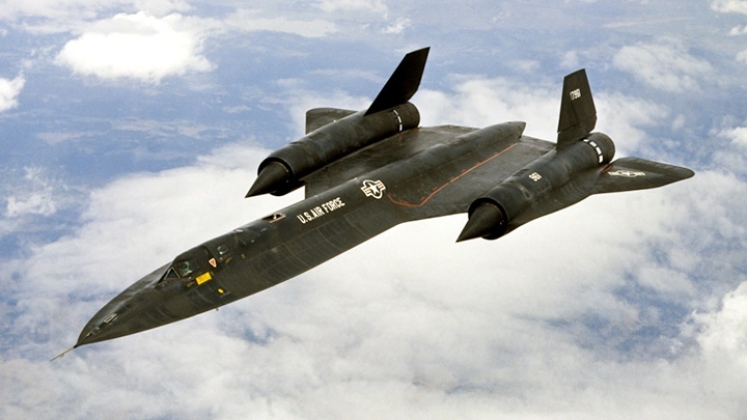During the Cold War the United States and Soviet Union both developed a number of combat and reconnaissance aircraft capable of operating at extreme speeds. Of those which entered service, the most notable where the Soviet MiG-25 which had interceptor, reconnaissance, strike and SEAD variants, its successor the MiG-31 which was built in interceptor and anti satellite variants, the CIA’s A-12 reconnaissance jet, and its more reliable successor which served with the U.S. Air Force the SR-71 Blackbird. The MiG-25 set records for altitude, and among combat aircraft was the fastest ever designed with the ability to surpass Mach 3.2, while the SR-71 was the fastest non-combat aircraft with a Mach 3.3 speed. A U.S. military project the late 1960s notably sought to capitalise on investments sunk into developing the SR-71 to develop a derivative capable of operating as an interceptor much as the MiG-25 did. With the F-108 interceptor program having been cancelled due to budgetary constraints, the U.S. Air Force still required a modern high speed interceptor for which a combat adaptation of the Blackbird, named the YF-12, was seen as the solution. The aircraft, which was expected to enter service as the ‘F-12,’ was set to be equipped by Lockheed Martin with a powerful AN/ASG-18 radar capable of detecting aerial targets over 800km away. The interceptor was also set to carry four long range AIM-47 missiles with ranges of over 160km and potent 100 pound high explosive warheads. Such an aircraft was ideally suited to intercepting Soviet bombers and reconnaissance aircraft near the U.S. mainland, with its high speed allowing it to respond quickly to any airborne threats detected.
 The U.S. Air Force placed an order for 93 F-12 interceptors, although these were cancelled when Defence Secretary Robert McNamara refused to release the necessary funds. As a result only three prototype interceptors were ever produced and the class ever entered service in the Air Force. The technologies developed for the F-12 did however serve in other American aircraft. The formidable AWG-9 radar and long range AIM-54 Phoenix missiles used by the F-14 Tomcat air superiority fighter were based closely on the F-12’s technologies, and the F-14 went on be considered the most capable fighter or interceptor of the Cold War era. The Tomcat was considered ideal for air defence duties on the U.S. mainland, but budgetary constraints restricted it to deploying exclusively as a carrier based fighter for the U.S. Navy. The aircraft was used as a long range interceptor by the Iranian Air Force during the Iran-Iraq War where it achieved a phenomenal 160 kills against Iraqi fighters for only three losses. Unlike the F-12, however, the F-14 was a relatively slow and low flying aircraft which limited its engagement range and its potency against high flying targets – with Iraqi MiG-25s proving difficult to intercept. Largely as a result of the F-12 program’s cancellation, the USSR remained well ahead in the capabilities of its interceptors. With the new generation of aircraft prizing manoeuvrability, and from the 1980s stealth, far more than speed or altitude, a combat aircraft capable of exceeding the Mach 3.2 record set by the MiG-25 in the late 1960s has yet to enter service anywhere in the world.
The U.S. Air Force placed an order for 93 F-12 interceptors, although these were cancelled when Defence Secretary Robert McNamara refused to release the necessary funds. As a result only three prototype interceptors were ever produced and the class ever entered service in the Air Force. The technologies developed for the F-12 did however serve in other American aircraft. The formidable AWG-9 radar and long range AIM-54 Phoenix missiles used by the F-14 Tomcat air superiority fighter were based closely on the F-12’s technologies, and the F-14 went on be considered the most capable fighter or interceptor of the Cold War era. The Tomcat was considered ideal for air defence duties on the U.S. mainland, but budgetary constraints restricted it to deploying exclusively as a carrier based fighter for the U.S. Navy. The aircraft was used as a long range interceptor by the Iranian Air Force during the Iran-Iraq War where it achieved a phenomenal 160 kills against Iraqi fighters for only three losses. Unlike the F-12, however, the F-14 was a relatively slow and low flying aircraft which limited its engagement range and its potency against high flying targets – with Iraqi MiG-25s proving difficult to intercept. Largely as a result of the F-12 program’s cancellation, the USSR remained well ahead in the capabilities of its interceptors. With the new generation of aircraft prizing manoeuvrability, and from the 1980s stealth, far more than speed or altitude, a combat aircraft capable of exceeding the Mach 3.2 record set by the MiG-25 in the late 1960s has yet to enter service anywhere in the world.
